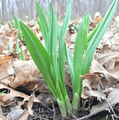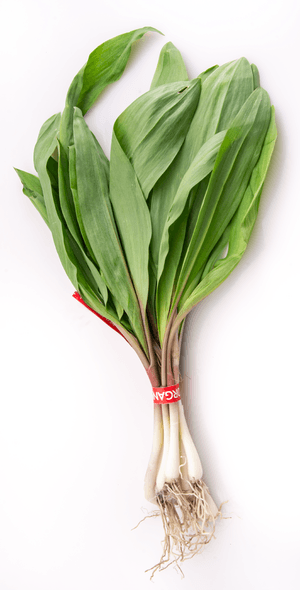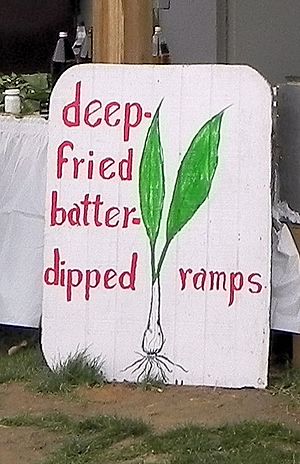Ramps (plant) facts for kids
Quick facts for kids Ramps (plant) |
|
|---|---|
 |
|
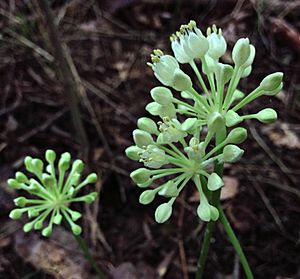 |
|
| Leaves and flowers | |
| Scientific classification | |
| Synonyms | |
|
Synonymy
Aglitheis tricoccum (Aiton) Raf.
Allium pictum Moldenke Allium tricoccum f. pictum Moldenke Allium triflorum Raf. Ophioscorodon tricoccon (Aiton) Wallr. Validallium tricoccum (Aiton) Small Allium burdickii (Hanes) A.G.Jones |
Allium tricoccum is a type of flowering plant. It's often called ramp, ramps, wild leek, or wild garlic. This plant is a kind of wild onion. You can find it all over eastern Canada and the eastern United States.
Many of its common names are also used for other similar plants, especially Allium ursinum. That plant grows in Europe and Asia.
Contents
What Ramps Look Like
Ramps are plants that grow back year after year. They grow from a bulb that looks like an egg or cone, about 2–6 cm long.
Usually, a group of 2–6 bulbs grows together. These bulbs produce wide, flat, smooth, light green leaves. The leaves are 20–30 cm long, including their narrow stems. The lower parts of the stems often have deep purple or burgundy colors.
The bulbs are white and covered by brownish or grayish layers. Each group of bulbs grows one flowering stem.
The flowers grow in a cluster called an umbel. This cluster is on a straight stem that is usually 10–40 cm tall. Before the flowers open, two oval-shaped leaves cover them. These leaves fall off when the flowers bloom.
The flowering stem stays even after the plant has made its fruit. Ramps usually flower after their leaves have died back. This is different from the similar plant Allium ursinum, where you can see leaves and flowers at the same time.
Ramps grow close together, with their roots just below the soil. They flower in June, July, or August. The flowers have white, cream, or yellowish petals that are 4–7mm long. The parts that hold pollen are about as tall as the petals.
After flowering, green fruits grow. They have three parts and open up in three ways. The seeds inside are round, black, and shiny.
How Ramps Are Named and Classified
The plant Allium tricoccum was first named in 1789 by a Scottish plant expert named William Aiton. He wrote about it in a book called Hortus Kewensis, which listed plants grown at Kew botanic garden in London. The plant was brought to Britain in 1770.
The name tricoccum means "having three seeds." This refers to the three seeds found in each fruit.
Different Types of Ramps
There are two main types, or varieties, of Allium tricoccum:
- Allium tricoccum var. tricoccum
- Allium tricoccum var. burdickii — also known as narrow-leaf ramps, white ramps, Chicago leek, or Burdick's leek
Sometimes, these two types are even considered separate species. The burdickii variety was first described in 1953. It was named after Justin Herbert Burdick, a doctor who noticed differences between ramp plants.
The two varieties have a few differences:
- A. tricoccum var. tricoccum is generally bigger. Its bulbs are larger, and its leaves are usually 5–9 cm wide.
- A. tricoccum var. burdickii has narrower leaves, usually 2–4 cm wide.
- The first variety often has red or purple leaf stems. The burdickii variety usually has white leaf stems.
- The first variety also has more flowers in its cluster, usually 30–50. The burdickii variety has fewer, about 12–18 flowers.
Where Ramps Grow
Allium tricoccum likes to grow in forests with rich, moist soil. You can find it in low areas, along stream banks, and on slopes where soil has collected.
The Allium tricoccum var. burdickii type is found in drier soils in upland forests.
Protecting Ramps
In Canada, ramps are seen as a special treat. They don't grow as widely there as they do in the Appalachian Mountains. Because people pick too many, ramps are a threatened plant in Quebec.
Under Quebec law, Allium tricoccum is a protected species. People can have ramps for their own use, but they can only pick up to 50 bulbs or plants per year. This is not allowed in national parks. The law also stops people from selling ramps. This means restaurants in Quebec cannot serve them. If someone breaks these rules, they can be fined.
However, some people still pick ramps illegally and sell them in Ontario, where it is allowed.
Ramps are also a "special concern" plant in Maine and Rhode Island. In Tennessee, they are picked for sale.
Why They Are Called "Ramps"
The name "ramps" is commonly used in the southern Appalachia region. It comes from an old English word, "ramson." This was the name for a European plant called bear leek (Allium ursinum), which is similar to our American ramp.
The old English word for ramson was hramsa. The word "ramson" itself was an old plural form, like how "oxen" is the plural of "ox."
Cooking with Ramps and Festivals
Allium tricoccum is very popular in the cooking of the rural areas where it grows. Both the white lower stems and the wide green leaves can be eaten.
Ramps are a popular spring vegetable. They have a strong smell like garlic and a clear onion taste. Ramps are also becoming more popular in restaurants across North America.
Their flavor, which mixes onion and strong garlic, works well in many dishes. In central Appalachia, ramps are often fried with potatoes in bacon fat. They are also scrambled with eggs and served with bacon, pinto beans, and cornbread. Ramps can also be pickled or used in soups and other foods instead of onions and garlic.
Many communities celebrate ramps with festivals:
- The town of Richwood, West Virginia, holds an annual "Feast of the Ramson" in April. Thousands of ramp fans come to try foods made with ramps.
- The city of Elkins, West Virginia, has the "Ramps and Rails Festival" in late April. It includes a cooking contest and ramp-eating contests.
- Cosby, Tennessee, hosts one of the oldest and largest ramp festivals in the U.S. It's called the "Cosby Ramp Festival" and has been held since 1954. It has had many visitors and famous musicians.
- Flag Pond, Tennessee, has its annual Ramp Festival on the second Saturday of May. It features many ramp dishes and Appalachian music.
- Whitetop, Virginia, holds its ramp festival on the third weekend in May. It has local music, barbecued chicken, fried potatoes, ramps, and green beans. There's also a ramp-eating contest for kids and adults.
- An annual ramp gathering in Haywood County, North Carolina, has attracted up to 4,000 people each year since about 1925.
- Huntington, West Virginia, has an annual ramp festival called Stink Fest. It's hosted by The Wild Ramp, a local farmers market.
- The Mason-Dixon park in Greene County, Pennsylvania, holds an annual ramp festival in late April. It offers ramp foods, music, crafts, and vendors.
- The Mason-Dixon Historical Park in Core, West Virginia, has a Ramp Dinner and Wildflower Walk each spring.
History and Fun Facts About Ramps
The city of Chicago got its name from the many ramps that grew near Lake Michigan in the 1600s. The Chicago River was named after the plant's local native name, shikaakwa (or chicagou). For a while, people thought the plant was Allium cernuum, but research in the 1990s showed it was actually the ramp.
Ramps are strongly connected to the old stories and traditions of the central Appalachian Mountains. People find the plant's very strong smell both interesting and funny. Once, a newspaper editor put ramp juice in the printer's ink as a joke, which made the U.S. Postmaster General upset!
People in Appalachia have long celebrated spring when ramps appear. They believed ramps were a special plant that could help them stay healthy and fight off sickness after winter. Ramps do have vitamins and minerals, which would have been helpful when people didn't have many fresh green vegetables in winter.
Native American Uses of Ramps
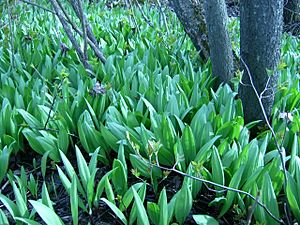
Ramps in Cooking
The Menominee, Cherokee, Iroquois, Potawatomi, and Ojibwa all use ramps in their traditional cooking.
Ramps as Medicine
The Cherokee also eat ramps as a spring plant to feel better. They use it for colds and for a cough called croup. They also use warm ramp juice for earaches.
The Ojibwa use a special liquid made from ramps to make people vomit quickly if they need to. The Iroquois use a liquid from the root to treat worms in children. They also use it as a spring tonic to "clean you out." Some Native Americans also used juice from crushed ramp bulbs to treat insect stings.
See also
 In Spanish: Puerro salvaje o rampa para niños
In Spanish: Puerro salvaje o rampa para niños



